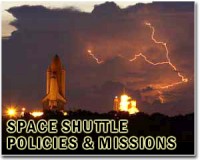 |
Washington (AFP) April 17, 2010 Astronauts aboard the space shuttle Discovery embarked Saturday on their journey back to Earth after undocking from the International Space Station (ISS), NASA said. The shuttle, after its delicate detachment from the outpost at 8:52 am (1252 GMT), completed an over 90-minute fly around of the station to take photos of the complex before heading on its deorbit flight path, the US space agency said on its website. The crew will end their 14-day mission on Monday, officials said, with an expected landing at Kennedy Space Center in Cape Canaveral, Florida at 8:51 am (1251 GMT). It has been a landmark mission in space exploration in a number of different ways: the first shuttle trip with three female crew members, who joined four male astronauts on the flight, and when they arrived at the ISS, it was the first time four women were in orbit at the same time. The mission also marked the first time there were two Japanese astronauts in space at once, with Discovery mission specialist Naoko Yamazaki joining Soichi Noguchi of the Japan Aerospace Exploration Agency, who arrived at the station on December 22. Discovery and its crew delivered nearly eight tonnes of cargo, including spare bunks for the occupants of the space station, a large tank of ammonia coolant and seven racks filled with science experiments. Among the gear hauled into space was a freezer to preserve samples of blood, urine, saliva, plants or microbes used in micro-gravity experiments for later analysis back on Earth. The shuttle also brought up to the ISS an exercise machine designed to study the effects of weightlessness on the body's musculoskeletal system. Muscles can atrophy during long sojourns in space so astronauts have to exercise regularly. During the shuttle's stay at the orbiting outpost, US President Barack Obama visited Kennedy Space Center to set a bold new course for the future of space travel ahead of the 30-year-shuttle fleet's retirement at the end of this year. Among the goals set for the US space effort, Obama on Thursday announced plans to send US astronauts into the orbit of Mars within the next three decades. He also sought to quell a storm of outrage caused by earlier administration plans, vowing before NASA staff that he was "100 percent committed" to their mission and to the future of the US space agency. "I believe that space exploration is not a luxury, it's not an afterthought in America's quest for a brighter future. It is an essential part of that quest," he said. Just three more space flights remain for shuttles Atlantis, Discovery and Endeavour, with a launch to the ISS in September scheduled to be the last of 134 total flights for the program before the three remaining orbiters are retired. The first shuttle flew in April 1981. After the shuttle fleet is grounded, US astronauts will be left to hitch rides on Russian spacecraft to the orbiting station until a replacement program is developed. The ISS, which orbits 220 miles (350 kilometers) above Earth, is a 100-billion-dollar project begun in 1998 with the participation of 16 countries, financed mainly by the United States.
Share This Article With Planet Earth
Related Links Shuttle at NASA Watch NASA TV via Space.TV Space Shuttle News at Space-Travel.Com
 Discovery docks with space station
Discovery docks with space stationCape Canaveral, Florida (AFP) April 7, 2010 The crew of the US shuttle Discovery were welcomed with hugs and handshakes Wednesday aboard the International Space Station after a successful docking high over the Caribbean. As the hatch between the two space ships opened at 0911 GMT, the seven astronauts floated in one by one into the embrace of the International Space Station's six crew members, who took pictures and video-taped the occ ... read more |
|
| The content herein, unless otherwise known to be public domain, are Copyright 1995-2010 - SpaceDaily. AFP and UPI Wire Stories are copyright Agence France-Presse and United Press International. ESA Portal Reports are copyright European Space Agency. All NASA sourced material is public domain. Additional copyrights may apply in whole or part to other bona fide parties. Advertising does not imply endorsement,agreement or approval of any opinions, statements or information provided by SpaceDaily on any Web page published or hosted by SpaceDaily. Privacy Statement |